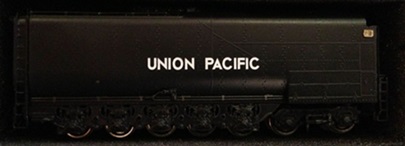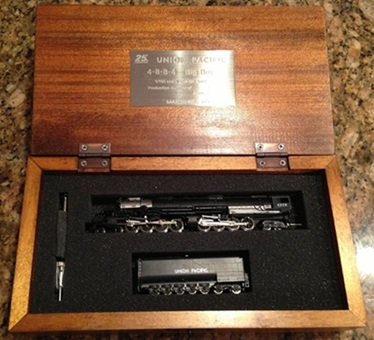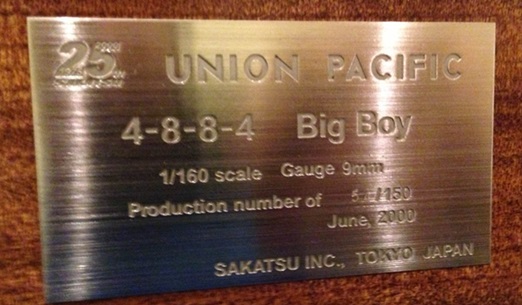



Introduced: 2000
Sakatsu (a famous Japanese hobby shop) released these models in 2000 as part of their 25th anniversary celebration. Production was limited to 150 units (manufactured by Korea Brass Co). These were available in two different factory-painted versions ("early" and "late"), and in seven different road numbers. Most of them (100+ were sold in Japan) and the rest were sold in the United States. Retail price was $1390.
As pictured below, Oriental Limited ordered a production run of their own from KBC (to be distributed in the US). This was all done without Sakatsu's knowledge or permission, and they eventually had to take OL to court to put a stop to it. After that, Sakatsu started sending a rep to the factory to closely monitor their tooling, thus making sure that KBC never allowed anyone else to make use of it.

As pictured below, the Big Boys sold by Sakatsu came in attractive wooden boxes -


Features include constant intensity lighting, a Japanese Canon coreless motor (LN-14) and Micro-Trains couplers. The forward engine pivots, whereas the rear engine does not (as per the prototype). The #3 drivers on the front engine are geared, as are the #2 drivers on the rear engine. All drivers have coiled suspension springs. The motor is mounted on a torque arm (allowing it to move in concert with the drivers). There are no traction tires. The drivers pick up right rail current and the tender wheels pick up left rail current. Current is tranferred from the tender to the locomotive by way of a single stiff wire on the tender drawbar. The minimum radius for curves is around 24".
I have never owned one of these, but I'm told by others that they are pretty poor runners (noisy and herky-jerky). Evidently the workers at KBC lacked the necessary skill to put these models together correctly, and many of them wound up being returned to the factory for tuning and repair. The Big Boy sent to Model Railroader for review was an extreme example of this, having been tweaked and tuned to run as smoothly as possible. Consequently, said review should be taken with a grain of salt - the rest of them do not perform that well.
Grade: Incomplete
Reviewed: 1/01 Model Railroader ("The prototype UP 4-8-8-4 Big Boy was a massive machine, and it's now available in N scale in two versions. The locomotives are imported brass factory-painted and lettered models made to celebrate the 25th anniversary of Sakatsu Co., a Japanese model railroader supplier... Both of our samples nicely matched (prototype) dimensions. The Sakatsu model follows typical brass model construction. The boiler and tender shells are fabricated of formed sheet brass with finely etched seams and rivet detail. Piping and grab irons are formed brass wire while the air pumps and other details are lost-wax brass castings.
"The articulated mechanism has the rear engine attached to the boiler while the front engine is free to move from side to side to follow curves in the track. However, this pivot is in the center of the front engine instead of at the rear as on the prototype. A husky Canon coreless motor powers all of the drivers through a hidden universal and matching gearboxes. All of the RP25 wheelsets are nickel-silver plated and they match the NMRA N scale standards. One side of each wheelset is insulated, so electrical pickup is accomplished through the engineer's side of the locomotive and fireman's side of the tender. The tender details include the slope sheets and stoker screw in the coal bunker. All of the rigid-frame truck sideframes are lost-wax brass castings including the appropriate five-axle rear tender truck. A spring-loaded drawbar connects the tender to an insulated pin on the rear engine frame. There is no provision for DCC, but the large tender offers plenty of room for a decoder.
"These models come ready-to-run, so the only assembly work is adding an optional front coupler. Sakatsu supplies an assembled MT Z scale coupler for this purpose. An MT N scale coupler is mounted on the rear. Two versions of the Big Boy are available. The early one has visible cooling pipes on the pilot deck, while the later version has coal boards on tender, a smoke deflector on the cab roof, and no cooling pipes up front. The paint jobs on both locomotives have a nice, smooth semigloss finish. The separation lines around the silver smokebox and firebox are clean and sharp. Each model is lettered and has an etched UP shield mounted just below the headlight. Early versions are numbered 4002, 4004, 4007, 4008 and 4011; late versions are 4023 and 4024. Our sample Big Boys were a little jerky at their initial starting speeds, but settled down after a two or three minute run-in polished the motor armature contacts. Then both models ran smoothly and steadily at the minimum speed, but produced a whine at high speeds. Their drawbar pull is equivalent to about 31 free-rolling cars on straight and level track. Both models are superb replicas of the UP's most famous freight locomotives. $1390")